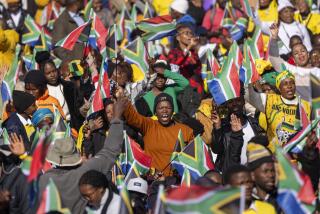S. Africa Blacks Protest Whites’ Hospital Policy
- Share via
JOHANNESBURG, South Africa — About 200 blacks, supported by throngs of singing protesters, sought and received treatment at eight whites-only hospitals in South Africa on Wednesday, launching a sweeping new program of civil disobedience to force an end to apartheid.
Qondile Dube, a young black woman with a hip ailment, started the “defiance campaign” by walking through the glass doors of the segregated white Johannesburg General Hospital. She was followed by a parade of blacks, from infants in arms to elderly women in wheelchairs, arriving by bus and taxi-van from nearby black townships.
The Mass Democratic Movement, a loose coalition of the country’s leading anti-apartheid groups, organized the protest, which was modeled on the 1952 defiance campaign led by Nelson R. Mandela and his African National Congress.
Similar actions are planned for whites-only nursing homes, beaches, parks, buses and schools in the weeks before and after the Sept. 6 parliamentary elections, in which blacks have no vote.
“Our defiance campaign will be taken to every corner and every section of society until apartheid is unworkable,” Jay Naidoo, secretary general of the Congress of South African Trade Unions, told a cheering rally in Johannesburg. “This is just the beginning.”
Twelve white women holding placards in support of the passive resistance campaign were arrested in Johannesburg and later released. No other arrests or violence were reported, however, and large police contingents generally remained out of sight, making no attempt to disperse crowds.
Nearly 2,000 protesters showed up at the beachfront Addington Hospital in Durban to cheer on about 150 black and Indian patients there. Several hundred attended a public meeting at the medical school next to Johannesburg General, where 55 black patients sought treatment. Smaller numbers of black patients showed up at hospitals in Pretoria, Vereeniging and other communities.
Protesters carried signs reading, “Apartheid Health Stops Here,” “We Won’t Tolerate Segregation Any Longer” and “AIDS--Apartheid Is a Damn Shame.”
Hospitals treated all the black patients, avoiding any confrontations as dozens of reporters and foreign diplomats watched.
Movement leaders described the protest, one of the most ambitious in South African racial history, as a breakthrough, and they urged blacks to continue using white hospitals.
“We have won a great victory for non-racialism today,” said Dr. Clive Rosendorff, dean of the University of Witwatersrand Medical School, which uses Johannesburg General as its teaching hospital. “What was done today was done in the great tradition of Mahatma Gandhi and Martin Luther King Jr.
“The government has said apartheid is dead. That’s a lie,” he added. “We see it around us all the time. And we are humiliated and embarrassed to have to practice apartheid medicine.”
But hospital administrators noted that white hospitals have been treating black patients for several years.
“The only difference today is the numbers,” said Sandy Schneider, nursing service supervisor for Johannesburg General.
She said that of the 300 emergency patients and 1,300 outpatients seen there every day, usually 15 to 30 are black. Twice that many were treated Wednesday.
Hospitals are racially segregated in South Africa, but a few high-technology units are open to all races. Hospitals are also supposed to treat emergency patients, regardless of color, until their condition stabilizes and they can be moved to their own hospital.
“There’s absolutely no precedent being set here today,” said Dr. Reginald Broekmann, superintendent at Johannesburg General. About 11% of his patients, on average, are black and most are treated in specialized units such as cardiac surgery, kidney dialysis and pediatric surgery.
One of the more racially mixed units at Johannesburg General is pediatrics, where 21 of 38 patients in three wards Wednesday were black.
“I’m not trying to say everything is completely open,” said Dr. Alan Rothberg, head of pediatrics. “But despite the restrictions, I think our people recognize the problem and are willing to help people.”
Defiance campaign leaders say they hope the protest will open some white hospitals and stretch the unofficial open-door policy at others.
“We’re saying, if the hospital is treating blacks as well as whites, then let them announce to Johannesburg’s blacks that they can come here,” said Dr. Max Price, a spokesman for the National Medical and Dental Assn. “They’re afraid to say that to the white electorate, and we’re putting them on the spot.”
Most health experts say the level of medical care at black hospitals, such as the massive Baragwanath Hospital in Soweto, is as high as that available at white hospitals.
But the facilities are vastly different. While white hospitals are clean, modern and generally uncrowded, most black hospitals are older and severely overcrowded. For every patient in a bed at Baragwanath, for example, there are at least two sleeping on the floor.
Qondile Dube, 31, who walks with a leg brace resulting from a bout with polio when she was a year old, went for treatment of a chronic hip inflammation related to the polio. She was examined by an emergency room physician, who prescribed a series of antibiotics--and suggested that next time, she visit the black clinic closer to her home.
But Dube said she might return to the white hospital anyway.
“It’s faster on this side,” she said, noting that she was in and out of the hospital in less than 90 minutes. “At my clinic you can come in at 7 a.m. and the doctor won’t see you until 11 a.m.”
The African National Congress’ 1952 defiance campaign was its most successful organized resistance in South Africa. About 8,500 people were arrested when they walked through “Europeans-only” entrances at railway stations, stood at whites-only post office counters and defied other apartheid laws.
Among the leaders were Mandela and Walter Sisulu, both of whom were convicted of sabotage in 1964 and sentenced to life in prison.
More to Read
Sign up for Essential California
The most important California stories and recommendations in your inbox every morning.
You may occasionally receive promotional content from the Los Angeles Times.














